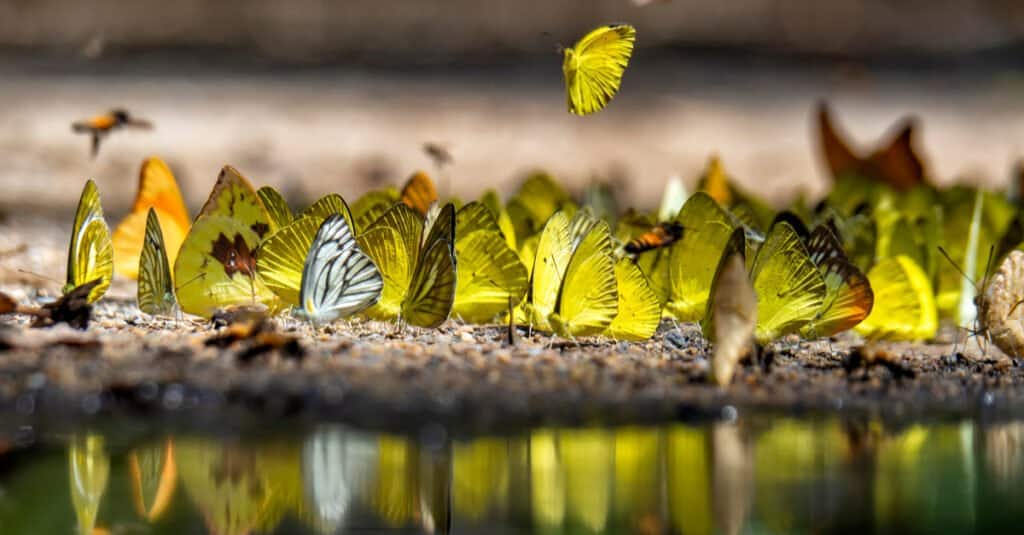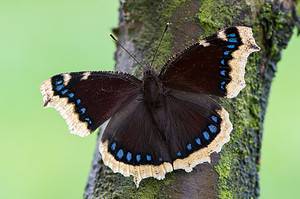According to the Smithsonian Institution in the United States, there are approximately 17,500 species of butterflies in the world today. These species inhabit every continent except Antarctica where conditions prove too cold for these delicate creatures. About 750 species inhabit the United States alone.
With so many butterflies in the world, one would think they band together to improve their odds of survival. This is what migratory birds do. Butterflies are more solitary than birds. The beautifully colorful spectrum of butterfly species typically live and migrate alone, except when gathering in groups for food, water, and minerals. Some, like the Monarch butterfly, also join together for stops in their migrations. Then they continue flying alone to go the distance.
Of course, male and female butterflies also come together to sexually reproduce. They find each other through their wings’ colorful displays and communicate their intent to mate by use of pheromones.
What is a Group of Butterflies Called?

©Santi S/Shutterstock.com
There are multiple collective nouns for a group of butterflies. The first collective noun is “kaleidoscope.” This is perhaps the most interesting name for the group. It comes from the beautiful array of colors and patterns that many fluttering wings create. This group name comes from the kaleidoscope, an optical instrument that creates a beautiful colorful display using mirrors. Similarly, the wings of butterflies feature thousands of reflective colorful scales, so this name makes great sense!
Another collective noun for a group of butterflies is flutter. It is easy to imagine that this descriptive name relates to the fluttering of wings within the group. Other names include flight, swarm, army, wing, rabble, flock, roost, and bivouac.
A bivouac is a temporary camp set up by soldiers. This name is well-suited to the congregation of many butterflies on one tree or other objects as they rest together during individual migration. In fact, during one migration period, the same group of butterflies can be described as a kaleidoscope in flight and a bivouac at rest. One can also say they are a swarm when they find a water puddle and many join together to take a drink.
Many sitting still together roost in the same place like a tree branch or on a fencepost, usually for nighttime rest. Butterflies only fly during the day and rest with their wings closed, meaning folded upward, after dark. They also roost if they are cold. Their wings do not work in cool temperatures. So they sit still on a safe landing spot, sometimes in a group of butterflies, wings open to attract the sun’s warmth and heat their bodies until they can take flight again.
Why do Butterflies Form a Group?
Butterfly groups are less common than solitary butterflies, especially since some species of butterflies only live for several days. They usually only group for food, hydration, migratory rest or to take in important minerals they do not get from their favorite meal, nectar. Occasionally in the wild, you can see two courting butterflies fluttering together or even mating. During this courtship, the pair flutters in the air to show each other they are healthy and ready to mate. But their union is brief and they do not linger in a pairing.
If you see a group of butterflies, it is an eye-catching and awe-inspiring experience! They are most often seen together on a tree or other object where they rest during migration, such as from Mexico into the United States or Canada. Or maybe they have found a soothing puddle of water from which many can drink at once, just like the American snout butterflies often do as they migrate from regions of drought.
Sometimes it is possible to see multiple butterflies eating from the same rotting fruit, animal dung pile, or a rotting animal carcass. They group together for these feedings because they need sodium and other nutrients they cannot get from a beautiful flower’s nectar.
It is also possible to see many butterflies in one field or garden. These are not working together in a group, however. Instead, they are probably individually attracted to a “super bloom,” the time when many flowers blossom and provide lots of sweet nectar. A good example of a super bloom is the annual event of migrating painted lady butterflies who take advantage of California fields of wildflowers during their flight from Mexico.
How to Attract Groups of Butterflies
There is something eternally mystical and cheerful about butterflies. They are a symbol of spring, sunlight and joyfulness, and are believed to be bringer of good luck and prosperity by many cultures around the globe. If you have a little space in your yard or garden, you can easily grow a butterfly haven. By planting flowers that butterflies feed on, it is possible to attract groups of them. Of course, the butterflies appear individually and fly from flower to flower alone. But with sweet-tasting nectar available, one small garden can attract many butterflies each day during peak flowering season.
Here are some useful tips that will help you create a butterfly garden:
- Butterflies love sunlight, choose a space that has ample amount of sunlight throughout the day.
- If the space has too much air flow then it will be difficult for butterflies to settle. Cover the space or choose one where the is less air flow.
- Butterflies feed on nectar, and if you want to attract different kinds of butterflies have various flowering plants in our butterfly garden. Some of the best flowering plants that attract butterflies include:
- Butterfly bush
- Lavender
- Bluebells
- Marigolds
- Lantana
- Buttercups
- Coneflower
- Hyacinth
- Black-eyed Susan
- Herbs, such as Clover, Willow-herbs, Mint, Marjoram, Knapweed, Thistles, Blackberry and Heather
- Bowles’ Mauve wallflower
- Do some research to find out what kind of butterflies are a regular in your area, and if you live in a zone that many species use as migratory route.
- Create a compost heap that has rotting fruits and vegetables.
- Butterflies need water to survive, just like any other living being, however, they cannot drink from traditional sources like pod, fountain, water bowl etc. They sip water from the soil, so make sure that your garden bed is moist and contains healthy levels of water.
- If the butterflies lay eggs all the better for your garden. Here are some weeds and herbs that are good for the larvae:
- Nettles
- Ragwort
- Grasses
- Ivy and holy
- Thistle
- Do not use chemical fertilizers, pesticides and insecticides. Try to use natural means that can be created from fruits and herbs to deter birds, pests and insects that pose a threat to the butterflies.
How to Attract Groups of Caterpillars

©Chongsiri Chaitongngam/Shutterstock.com
A home garden can also attract butterflies specifically for egg-laying and caterpillar growing purposes. In other words, you can create a safe place for butterflies to go through their entire life cycle, from egg to larva, then pupa to beautifully winged butterfly!
Groups of caterpillars hatch and feed on specific plants where their female parent lays her eggs. The female butterfly specifically hunts for plants that caterpillars can eat when she is ready to deposit eggs. Some adult female butterflies use their feet to briefly land on a plant and detect whether it makes a suitable home for their offspring. These are called host plants. Sometimes it is easy to see tiny butterfly eggs on the plant stalks or undersides of leaves.
The right plants provide all of the nourishment the growing caterpillar needs until they form a chrysalis as part of the pupal stage. After many eggs hatch, it is possible to find multiple caterpillars living together on one plant. You can also find them where bite marks are left in leaves, clearly showing that a hungry caterpillar is munching its way around the host.
Plants that attract egg-laying butterflies, feed groups of caterpillars,s and host chrysalises include:
- Milkweed for the monarch
- Carrots, rue, parsley, dill or fennel for the black swallowtail butterfly
- Wild cherry, birch, ash, poplar, apple tree, tulip tree or sycamore for the tiger swallowtail
- Dutchman’s pipe for the pipevine swallowtail
- Violet for the great spangled fritillary
- Snapdragon for the buckeye butterfly
- Willow or elm for the mourning cloak butterfly
- Sunflower for the Gorgone checkerspot butterflies
- Helenium for the dainty sulphur butterfly and painted lady butterfly
- Lupine for the silvery blue butterfly
When the chrysalises open and winged adult butterflies emerge, it is sometimes possible to see a kaleidoscope, swarm, or roost of young butterflies for a sunny afternoon as they stretch out their wings and warm them in the sun before they fly off into the world.
Next Up…
- Butterfly Predators: What Eats Butterfly?: Find out what kind of predators you need to keep away when you create your beautiful butterfly garden.
- Do Butterflies Lay Eggs? Butterflies spend a lot of time procreating during their short life. Find out how they create the next generation of butterflies.
- 10 Incredible Butterfly Facts: If you are a butterfly enthusiast, find out some facts that you may not know.
The photo featured at the top of this post is © KPixMining/Shutterstock.com
Thank you for reading! Have some feedback for us? Contact the AZ Animals editorial team.






